Coolers for Socket 478, Spring/Summer 2002
|
Part 1. AVC, Spire and GlacialTech coolers

The market (be it American, European or any other) does not offer a
great variety of cooling systems for the Intel Pentium 4 platform. As for
the Socket 423, it was clear from the very beginning that this socket would
be just a buffer between the good old Socket 370 and Socket 478 which is
going to occupy the market for a long good while. That is why a lot of
major cooler makers didn't feel a desire to invest much into new models
for Socket 423, that is why they brought on the market just one or two
coolers.
However strange it may be, the Socket 478 is in the same situation.
In spite of agressive promotion of the Pentium 4 platform and an increasing
number of its followers among enthusiasts, as well as among corporate users
and even economical customers, there is some shortage of quality and effective
coolers. A lot of producers are still at the stage of marketing investigations
and they do not pay due attention to an extension of the Socket 478 cooler
range. But we shouldn't disregard box versions of processors which come
with decent coolers and are offered at quite attractive prices. Probably
this is why some cooler makers dislike the Pentium 4 platform. However,
OEM processors also need efficient and quality cooling systems.
So, let's see what the market can offer us today. We will examine both
traditional and new trade marks, study performance characteristics of their
coolers and carry out a comparison analyses.
AVC 117141 (SunFlower)
Produced in collaboration of Intel and AVC (Asia Vital Components), the
SunFlower is one of the pioneers in the sector of Socket 478 processor
cooling systems. Although the SunFlower is already a year old it is still
able to cope with its mission of a reference cooling system for Pentium
4 Northwood processors.
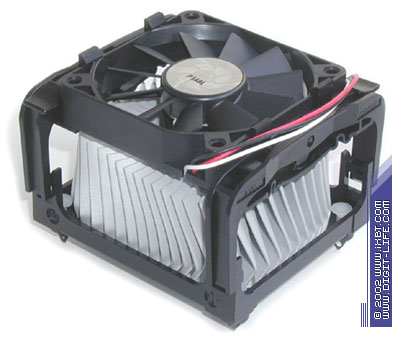
The main distinguishing feature of the SunFlower is how the heatsink is
implemented: a radial finned contour measuring 80x70x35 mm houses a copper
core of 30 mm in diameter and 20 mm high. According to AVC, the configuration
of the radial finning was carefully being developped for quite a long time
to reach an ideal fin shape from the thermal and aerodynamic standpoints.
Well, the fin is 2 cm wide in average, 0.8 mm thick and the heat exchange
surface is about 1000 cm2), contrary to much more decent parameters
of famous Orb coolers. The cooler's construction (the fan is lifted above
the upper edge of the heatsink by 5 mm, the fins are tilted in a direction
opposite to impeller's rotation) reduces a hydraulic resistance and improves
conditions of ventilation. Besides, each fin has a special bend near the
heatsink's base which serves as a flow energizer in interfin channels and
makes heat exchange more intensive.
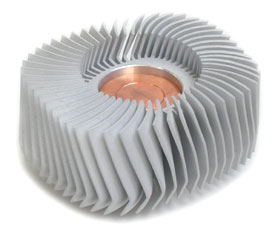
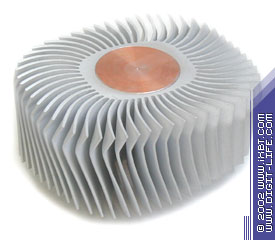 The advantage of the copper core is obvious: you all know the difference
between thermal-conductivity coefficients of copper and aluminum. However,
we must remember that a dirty contact of an aluminum circuit and a copper
can can diminish such advantages. But the company assures that molding
of the heatsinks is carried out with all requirements taken into account.
Thus, they guarantee almost impeccable quality of a thermal contact of
the contour and core.
The advantage of the copper core is obvious: you all know the difference
between thermal-conductivity coefficients of copper and aluminum. However,
we must remember that a dirty contact of an aluminum circuit and a copper
can can diminish such advantages. But the company assures that molding
of the heatsinks is carried out with all requirements taken into account.
Thus, they guarantee almost impeccable quality of a thermal contact of
the contour and core.
It makes us believe in a good cooler's performance. And the test results
of the SunFlower demonstrate really good effectiveness close to the leaders
of our test, even despite a low-powerful fan measuring 70x70x15 mm with
the impeller's speed being 3800 rpm. Such relatively weak fan is rather
useful than harmful because the cooler's noise level doesn't exceed the
sanitary level of 45 dBA.
The only drawback of the SunFlower is its fastening system. For flawless
installation one has to demount a retention mechanism assembly of the mainboard
and then install the cooler using its own mechanism. Such approach is not
always convenient because if a board is already installed in the system
unit it's necessary to demount it.
Spire 9T207B1H3G (IceStream) and Spire 9T207B1M3G (QuietStream)
Spire coolers produced by the Dutch company Fanner Tech are known as solid
effective cooling systems. And today we have two new coolers - IceStream
and QuietStream.
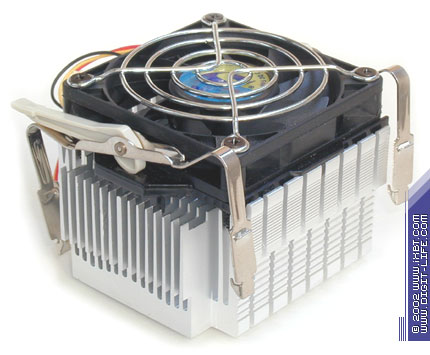
The IceStream cooler has a big heatsink (88x76x40 mm) and a fan measuring 70x70x15
mm with an impeller rotating at 4500 rpm. The cooler has excellent fin parameters,
i.e. a trapezoidal fin section (1.2 mm wide at the base and 0.6 mm wide
above, i.e. we have a classic ratio of 2:1 typical of fins with a constant heat
flow density). Such configuration improves thermal efficiency considerably (as
we found out in the GlacialTech
Igloo 2310 and Igloo 2400 Coolers Review). Besides, the heatsink base has
a hump in the center which reduces a negative effect of heat flow spreading resistance
and, thus, makes an overall thermal resistance lower). That is why this is quite
an advanced solution, not just a piece of aluminum "flavored" with a fan.
The QuietStream cooler is identical to the IceStream in appearance and
has all the same advantages. The only difference is a low-speed fan
(only 3500 rpm). But this allows the cooler to maintain a low noise level,
justifying its name. But the thermal efficiency is not much lower which
means that this is a more optimal combination of a fan and a heatsink than
in the IceStream.
The installation makes no problems. The IceStream and QuietStream have
handy clips of a lever type that provides hold-down pressure of 14 kg which
complies with the norms. The clips have rests for screw-drivers which come
in useful for installation and deinstallation. In addition, both models
come with the Stars 420 heat interface (which is a clone of the Dow Corning
SH340 glue where zinc oxide is a basic component).
GlacialTech Igloo 4300, Igloo 4200 and Diamond 4000
The GlacialTech coolers for Socket A processors reviewed in the GlacialTech
Igloo 2310 and Igloo 2400 sport nice thermal efficiency and performance characteristics.
New models of GlacialTech coolers for Socket 478 have also high quality and efficiency.
The Igloo 4200 cooler is a combination of an aluminum extrusion heatsink
of 83x69x34 mm and a fan measuring 60x60x20 mm; it inherits all key features
from the Igloo 2310 and Igloo 2400.
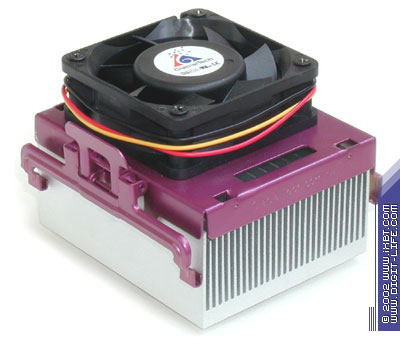
Here we again have three catalysts of thermal efficiency: an advanced fin
of the trapezoid section which is 0.8 mm wide in average at the base and
0.3 mm above, varying height and a fan shifted to the front part of the
heatsink. Again it allows us hope for geed performance.
Well, the Igloo 4200 arises no doubts in its impeccable performance.
Its overclocked modification - Igloo 4200 Pro (4800 rpm fan) goes into
the leading group - it just lags behind the Volcano 7+ from Thermaltake
but at the same time its noise level is still much lower (by 13 dBA). The
standard modification of the cooler - Igloo 4200 (4200 rpm fan) doesn't
make much noise either and performs very close to the leaders. The Igloo
4200 Light (3500 rpm fan) shows the lowest noise level today, but it also
goes on a par with many other coolers in thermal efficiency, thus, taking
the golden mean.
The most peculiar feature of the Igloo 4200 is not its high thermal
efficiency coupled with a low noise level, but a handy fastening system
(which is a subject to several patents, in particular, US6404633 and DE20115128).
At the expense of the elaborated construction of this system installation/deinstallation
of the cooler is very easy and takes only 10-15 sec. You don't need much
force or screw-drivers - you just have to fix the special case in the RM
module then easily lift the handle and that's all!
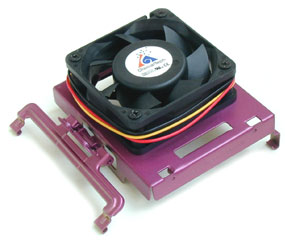
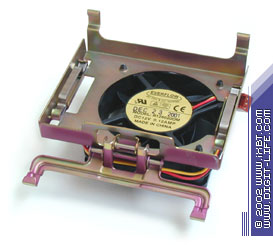 Apart from easy installation the Igloo 4200 sports one more excellent feature.
Many coolers with an ordinary lever-based mounting system have two main
pressure points (where a narrow "heal" of the lever touches the stop face
of the heatsink) - it can distort the heatsink during installation. Besides,
the mainboard can also become bent under the socket which is not advantageous
though it is allowed according to the Intel's specs for Socket 478 coolers.
Apart from easy installation the Igloo 4200 sports one more excellent feature.
Many coolers with an ordinary lever-based mounting system have two main
pressure points (where a narrow "heal" of the lever touches the stop face
of the heatsink) - it can distort the heatsink during installation. Besides,
the mainboard can also become bent under the socket which is not advantageous
though it is allowed according to the Intel's specs for Socket 478 coolers.
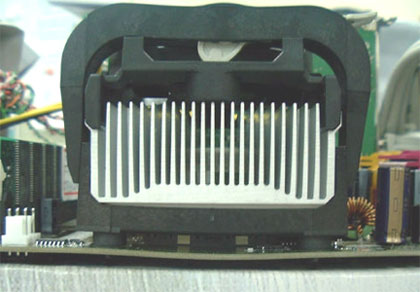
The fastening system of the Igloo 4200 realized another approach. Here
the heatsink is pressed with flat metallic springs 25 mm long and 4 mm
wide mounted to the internal surface of the case. It allows distributing
the hold-down pressure more uniformly (which equals 12 kg) and providing
a close high-quality contact between a processor and the heatsink without
distortions. A probability that a mainboard can become bent under the socket
is almost zero.
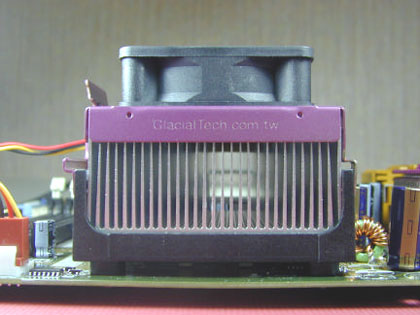
One more advantage of the cooler is a preinstalled "silver" thermal interface
(with 5% of silver oxide) which possesses decent physical and chemical
properties and not bad effectiveness. At present this is a standard feature
of all GlacialTech solutions for Socket A and Socket 478.
The Diamond 4000 cooler has the same dimensions and design as the Igloo
4200, as well as the "idea content" (advanced heatsink, shifted fan of
60x60x20 mm, handy mounting system); but it also has new features.
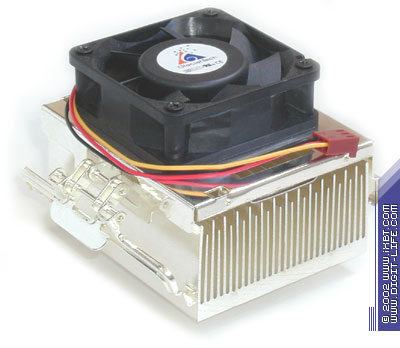
The first peculiarity is improved quality of heatsink's surface. The processing
includes not only etching or anodic treatment; the surface is also covered
with a special layer which consists mostly of metallic micro-powders (including
silver). As a result, the heatsink looks very attractively and provides
better heat removal from the finned surface. Besides, quality of processing
of the heatsink base got better as well - it looks almost like a mirror.
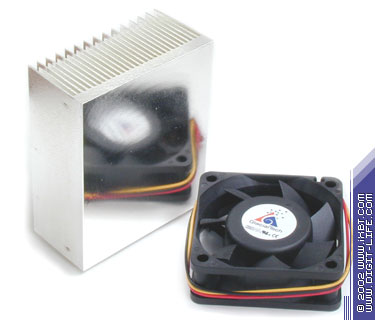
Another peculiarity of the cooler is a thermal control system which adjusts
a fan's speed from 2800 to 4800 rpm within the temperature range of 25-40°C.
The advantage is obvious: in case of good ventilation of the computer case
there is no need to maintain a high speed of the fan - you can reduce it,
thus, making the noise level lower as well. You don't have to use any additional
circuits or thermoregulators for a better efficiency-to-noise ratio, because
the integrated thermal control fulfills a correct regulation.
The last peculiarity is an altered design of the fastening case (its
sides are made 5 mm shorter). According to the engineers from GlacialTech,
it allows opening the heatsink entirely (from the aerodynamic standpoint),
improving ventilation in the upper finned part (where a flow speed is usually
very close to 0) and increasing the overall thermal efficiency.
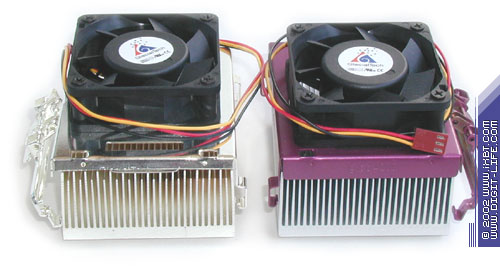
Our tests show that the Diamond 4000 packed into an old fixing system of
the Igloo 4200 has poorer thermal efficiency than the Diamond 4000 with
its
own fixer. At high fan speeds (4200-4800 rpm) the lag is 1°C, at lower
ones (3000-3600 rpm) it is within 2°C. Starting from July all modifications
of the Igloo 4200 will have the new fixer. This will grade up their temperature
parameters even more (the Igloo 4200 and Igloo 4200 Light will get a "discount"
of 1-2°C with the fastener from the Diamond 4000, the Igloo 4200 Pro will
have it within 1°C).
Well, the Diamond 4000 is really optimized to its most degree - it inherits
all the best from the Igloo 4200. Without unnecessary pomposity, this cooler
combines a nice appearance and a pleasant filling, thus, providing an excellent
combination of high efficiency and a low noise level in any conditions.
In our today's rating the Diamond 4000 takes leading positions in many
parameters easily outscoring not only its direct competitors but also its
senior brothers.
As for the Igloo 4300, this model is very similar to the Igloo 4200
- it boasts of the same heatsink and a similar fastening system. The crucial
difference is only one - it possesses a fan of 70x70x15 mm located right
in the center of the heatsink.
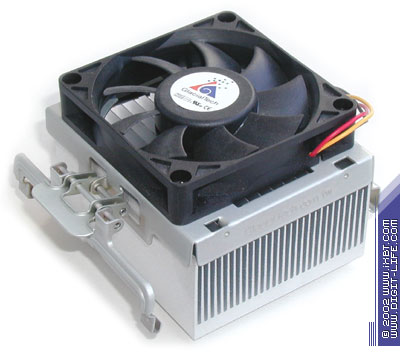
The Igloo 4300 is the senior and oldest model (it is a forefather in the
GlacialTech series for Socket 478). Unfortunately, age is not a trump,
and it also concerns the Igloo 4300: in spite of its power powerful fan
(36 CFM against 24 CFM of the Igloo 4200 Pro), this cooler has thermal
efficiency comparable to that of the Igloo 4200 but its noise level is
higher. It's obvious that the new generation (Igloo 4200 and Diamond 4000)
is really more optimized having a better efficiency-to-noise ratio. At
the same time, one shouldn't belittle advantages of the Igloo 4300, because
it still looks perfect and successfully fights against its competitors
as far as thermal efficiency and performance characteristics are concerned
(convenient fastener, quality fan, effective thermal interface etc.).
Write a comment below. No registration needed!
|
|
 |
|
|
|













